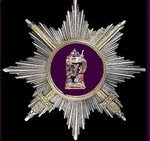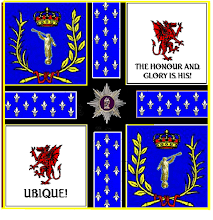 The Van Demon's Land Legion: Like many nations everywhere, The Holy Mormoan Kingdom of New Wales authorized the raising of Militia units, (Regiments, Battalions, Legions etc) very early in their history. The unit we will look at today is the Van Demon Legion
The Van Demon's Land Legion: Like many nations everywhere, The Holy Mormoan Kingdom of New Wales authorized the raising of Militia units, (Regiments, Battalions, Legions etc) very early in their history. The unit we will look at today is the Van Demon Legion NAME: The Van Demon's Land Legion
Date Raised: 21 March 1731
MOTTO: "Ready, Aye, Ready"
Unofficial Motto: "The Good Die Young".
Nicknames:"The Demons", "and “The Devil's Parrots"
Battle Honours: "Cadbury Hill 1733", "Launceston 1734", "Van Demon's Land Campaign" .
Brief History: In 1730 King Michael sent his Brother, Grand Duke Colin with 3000 subjects and 500 troops to establish a colony on a large Island south of the mainland called Van Demon's Land. This became known as The Grand Duchy of Van Demon's Land. The 500 troops Grand Duke took with him were predominantly men that had recently arrived from the “Old World” (the British Nth American colonies). These men, (and their families), were keen to prove their worth . As we know, these men formed the Clairmont Militia
Grand Duke Colin soon realised that a second Regiment would be required, and proclaimed that "A body of fine young men is required to be raised to assist in the protection of the Island Colony of Van Demon's Land".
Consequently the Legion was raised from the sons of those men who were serving in the Clairmont Militia, (and had been to young to join at the time of that regiments formation), and young gentry who had sailed to Van Demon's Land several months later in search of land to make their own.
As a result the average age of the "Rank and File" was quite young, (only 18 years).
Also, there was initially a shortage of uniforms and weapons, so they had to initially drill with spears! Additionally the only coats they initially could get were made from green cloth and quite large, as they were originally meant for the Clairmont Militia, who rejected them in favour of their Brown uniforms.
When the unit drilled or performed "exercises" (manouvers) the soldiers were often mocked by the "old Hands" in the Clairmont Militia; "This island is to small for two Regiments, and you parrots are too small for our hand-me-down coats"!!!
This is why the "Parrots" are a Legion. Their CO, an young officer named Daniel Dunbar replied one morning whislt they drilled, "Those old farts are right, this island is indeed to small for another Regiment, but we are a Legion"!!!
Like the Clairmont Militia, This Regiment fought at relief of Fort Clairmont in 1735, where they supported the Clairmont Militia well, but as they didn't fire a single shot, this isn't a Battle Honour for them.
Regimental anecdotes and traditions:
The first time the Legion saw action was at Cadbury hill when they were marching with the Maiden Guard, but somewhat to the rear. When the Natives attacked the Adjutant of the Maiden Guard rode up to the Legion an exclaimed, "The Maiden's are engaging the natives, will the Legion be able to support us"?
Major Dunbar replied "Aye Ma'am, we are ready! The good die young"!
Drummers in the Legion wear "Reversed Colours" as seen below:








